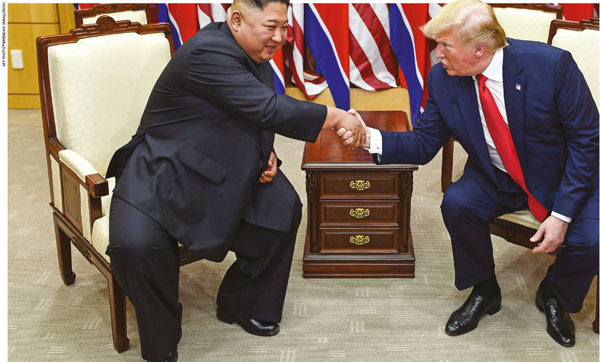CAMERA DIPLOMACY
PHOTO OPS THAT DIDN’T CHANGE THE WORLD
BY Angelo Fernando
When US President Donald Trump shakes hands with North Korean leader Kim Jong-un, it’s pure theatre. The photo ops then become ‘legacy shots’ and serve as the timestamp of a presidency like when Richard Nixon met Zhou Enlai in 1972, which represented a major diplomatic overture.
But these photo ops also have a mixed meaning at the time they’re taken. Trump and Kim appear to crave such pictures, as well as their symbolism – somewhat like teenagers who take selfies in front of a coffee shop to seek validation among their followers.
And like pop stars, PR hungry ‘peeps’ and businesspeople, many politicians also crave photo ops. On the biz front for instance, the late Steve Jobs and Sir Richard Branson have often made carefully stage-managed appearances.
 All of this prompts the question: why do it if it’s clearly understood that it is simply theatre or reality TV? One way to understand this besides recognising the presence of vanity is to shift the blame to the media – specifically, the 24/7 news cycle that the media has created and now feeds off.
All of this prompts the question: why do it if it’s clearly understood that it is simply theatre or reality TV? One way to understand this besides recognising the presence of vanity is to shift the blame to the media – specifically, the 24/7 news cycle that the media has created and now feeds off.
News around the clock would be mundane if it’s not punctuated by events or catastrophes. For those moments when crime scenes, accidents and catastrophes don’t provide visuals on what’s considered a slow news day, the media looks elsewhere.
In no particular order of importance, here are five photo ops that may have seemed important at the time but didn’t change the world.
ADOLF HITLER British Prime Minister Neville Chamberlain decided to cut a deal with German Chancellor Adolf Hitler in 1938 and flew to Munich for a meeting. Chamberlain, a former businessman, believed he could deal with Hitler in a practical and businesslike manner.
The photo shows Chamberlain and Hitler after they signed a pledge, which asserted that Britain and Germany would never go to war again. However, it meant nothing because Hitler snubbed the world and invaded the then Czechoslovakia six months later. The meeting failed to prevent World War II and Chamberlain resigned in May 1940.
GEORGE BUSH On 1 May 2003, barely three years after the US invaded Iraq, US President George W. Bush made a speech on board the USS Abraham Lincoln. Though the gist of his speech was “we have difficult work to do in Iraq,” the photo op was a way to project him as a tough military style leader and that the war was not a huge blunder.
It was theatre for another reason too. The aircraft carrier was only some 50 kilometres off the coast of California and Bush could have been flown to the venue in his helicopter. Instead, he flew in on a fixed wing aircraft and emerged for photographers with a helmet tucked under his arm. The war dragged on and US soldiers remained in Iraq until 2009.
DENNIS RODMAN In 2013, Dennis Rodman – a three time NBA champion – posed with the reclusive North Korean leader Kim Jong-un. As weird as this alliance seemed, the connection was based on Kim being a fan of the Chicago Bulls – and the eccentric basketball player imagined he could pull off some ‘basketball diplomacy.’
He also imagined himself to be in line for a Nobel Peace Prize. However, his photo ops don’t even start to compare with the ones pulled off by Trump – who once had Rodman on his reality TV show The Apprentice.
RICHARD BRANSON For the CEO of Virgin Atlantic Sir Richard Branson, there’s a simple formula for a product launch. Make a dramatic entry and create a photo op that the media will love.
In October 2011, he rappelled off a building in New Mexico to announce the company’s foray into space tourism.
Another stunt in downtown Toronto involved Branson being trapped in a steel cage that was suspended 25 metres in the air by a crane. He broke out of it amid staged pyrotechnics and rappelled down on knotted bed sheets.
The photo op was to declare that Canadian subscribers could be freed from their ‘mobile jail cell.’
DONALD TRUMP On 30 June, Trump crossed the DMZ between the two Koreas to shake hands with Kim Jong-un. The photo op was well planned; Trump took 10 steps into North Korea across a strip of concrete, the cameras clicked madly. Feigning their ‘friendship’ at a dangerous geopolitical line was a vanity moment for both leaders even though diplomacy takes a lot more grunt work.
One week later, Kim accused the US of heavy-handedness and the photo soon faded. But don’t worry, there will be plenty more to come to feed our appetites and fill the Instagram feeds.





Leave a comment